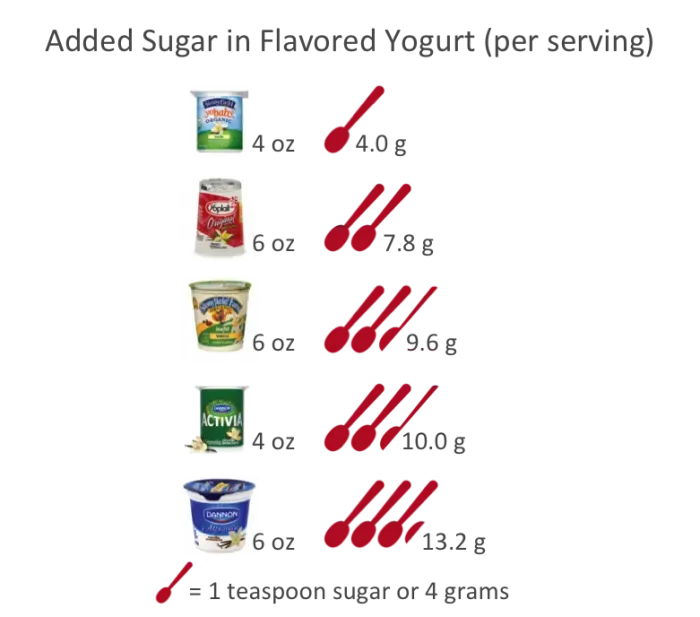Table of Contents
You're standing in the dairy aisle, trying to make a smart choice. Your eyes land on the "low fat yogurt" options. Less fat sounds good, right? It feels like a healthy win. You grab a carton, picturing a light and virtuous snack. But here’s the catch, and it's a big one that often gets overlooked: the term "low fat" doesn't automatically mean low sugar. In a classic move of food industry misdirection, removing the fat often means adding something else back in to make it taste good – usually sugar. Understanding the real amount of sugar in low fat yogurt is critical because those grams can pile up quickly, turning your seemingly healthy choice into something closer to a dessert. We're going to unpack what those labels actually mean and show you how to find yogurt that's genuinely good for you, without the hidden sweetness.
Why "Low Fat" Doesn't Always Mean Low Sugar

Why "Low Fat" Doesn't Always Mean Low Sugar
Alright, so you're digging into this topic, which is great because it's a common trap people fall into. You see "low fat" on a yogurt carton and your brain instantly says "healthy choice!" It makes sense, right? Less fat means fewer calories from fat, which sounds like a win for weight management or heart health. But here's where the food industry gets a little sneaky. When you strip out the fat, you often lose a lot of the flavor and that creamy texture people expect. To compensate for that, manufacturers frequently pump in sugar – sometimes a surprising amount – to make the product palatable and keep you coming back for more. This is the core issue when we talk about the actual sugar in low fat yogurt; you think you're cutting fat, but you might be loading up on added sweeteners without even realizing it.
Decoding the Sugar in Low Fat Yogurt Labels

Decoding the Sugar in Low Fat Yogurt Labels
so picture this. You've got the carton in your hand, you've bypassed the full-fat stuff, feeling pretty virtuous. Now you need to flip it over and look at the Nutrition Facts panel. This is where the rubber meets the road when figuring out the real story behind the sugar in low fat yogurt. Don't just glance at "Total Sugars" right away, because that number includes lactose, the natural sugar found in milk. What you're *really* hunting for is the line that says "Added Sugars." That's the stuff manufacturers put in to sweeten the deal, and that number tells you how much extra sweetener you're getting beyond what's naturally there. It’s a crucial distinction that helps you see through the marketing hype.
Keep an eye out for these common aliases for added sugar when scanning the ingredients list:
- Sucrose
- High Fructose Corn Syrup
- Fruit Juice Concentrate
- Cane Sugar or Cane Syrup
- Honey (yes, it's still added sugar!)
- Agave Nectar
- Maltodextrin
Picking Low Fat Yogurt with Less Sugar

Picking Low Fat Yogurt with Less Sugar
Start with the Basics: Plain is Your Friend
so you've decoded the label and realized that some of those "low fat" options are basically sugar bombs in disguise. So, how do you actually find the good stuff? The absolute easiest way to cut down on the sugar in low fat yogurt is to start with plain, unsweetened varieties. Think of plain yogurt as a blank canvas. It has the natural tang from the fermentation process and the inherent milk sugars (lactose), but none of the extra junk manufacturers pour in. It might taste a bit different if you're used to the fruit-on-the-bottom or flavored kinds, but trust me, this is where you gain control over your sugar intake.
Choosing plain also opens up a world of customization. Instead of relying on pre-mixed, often sugary fruit purees, you can add fresh berries, a sprinkle of nuts, or a tiny drizzle of honey *if* you really need sweetness (and you control the amount!). This way, you know exactly what's going into your bowl, and you're not getting blindsided by hidden sugars. It’s about taking back power from the marketing department and putting it back in your kitchen.
Become a Label Detective: Compare the "Added Sugars"
Once you're eyeing plain low fat yogurt, don't just grab the first one you see. Different brands can have slightly different textures or levels of tang, but more importantly, even some "plain" varieties might sneak in a sweetener or stabilizer that impacts the sugar count. This is where your label-reading skills from the previous section come into play again. Line up a couple of plain low fat options and compare the "Added Sugars" line side-by-side. Ideally, you want this number to be zero grams.
Sometimes, you'll find plain yogurts with a couple of grams of added sugar – maybe from a pectin or a processing aid that contains a sweetener, though this is less common in truly plain versions. But comparing labels is crucial. A flavored low fat yogurt might have 15-20 grams of added sugar per serving, while a plain one should have none. That difference is staggering when you're trying to manage your daily sugar intake.
Here's a quick comparison trick:
Yogurt Type | Likely "Added Sugars" per Serving (approx.) | What to Look For |
|---|---|---|
Plain Low Fat Yogurt | 0g | The ideal choice for minimal sugar. |
Vanilla Low Fat Yogurt | 8-12g | Vanilla flavoring often comes with added sugar. |
Fruit-on-the-Bottom Low Fat Yogurt | 15-20g+ | Fruit prep is usually loaded with syrup. |
Beyond Plain: What About Flavored Options?
Let's be real, plain yogurt isn't everyone's jam every single day. But if you venture into flavored low fat yogurt territory, you need to be extra vigilant about the sugar content. Some brands are starting to offer lower-sugar flavored options, often using alternative sweeteners or just significantly reducing the amount of sugar. These can be okay occasionally, but you still need to check that "Added Sugars" line religiously.
Look for brands that specifically market themselves as having "low sugar" or "no added sugar" *in the flavored varieties*. Even then, compare them to the plain versions. Sometimes the difference isn't as big as you'd hope, and you're still getting a dose of added sweetener. The goal is to find the best balance for you, understanding the trade-off between convenience and sugar intake. Picking low fat yogurt with less sugar means being an active participant in your food choices, not just trusting the marketing.
Making Smarter Choices About Sugar in Low Fat Yogurt

Making Smarter Choices About Sugar in Low Fat Yogurt
Take Control: Sweeten It Yourself
so you've mastered the art of reading labels and you're leaning towards plain low fat yogurt. Fantastic. But let's be honest, eating plain yogurt every single day can get a little... uninspired. This is where you become the master of your own yogurt destiny. Instead of buying pre-sweetened versions loaded with grams of sugar, buy the plain stuff and add your own flavor. A handful of fresh blueberries or raspberries brings natural sweetness and fiber. A sprinkle of cinnamon or a dash of vanilla extract can make a huge difference without adding any sugar at all. If you absolutely need a touch of sweetness, a tiny bit of maple syrup or honey (think a teaspoon, not a tablespoon) is better than the massive amounts found in many commercial flavored yogurts. You control the spoon, you control the sugar in low fat yogurt.
Think Beyond the Spoon: Yogurt's Role in Your Diet
Making smart choices about sugar in low fat yogurt isn't just about one cup; it's about how it fits into your overall eating pattern. Are you having yogurt as a snack, part of breakfast, or even dessert? If it's replacing a genuinely sugary treat, even a flavored low-fat yogurt might be a step in the right direction, though plain is still preferable. If you're eating it daily, those added sugars really start to accumulate and can impact your overall health goals, whether that's managing blood sugar, weight, or just feeling better. Consider what else you're eating throughout the day. Are you getting sugar from drinks, other snacks, or sauces? Yogurt is just one piece of the puzzle, but it's a piece where you can make a significant reduction in hidden sugar intake with relatively little effort.
- Always check "Added Sugars" on the label.
- Prioritize plain, unsweetened low fat yogurt.
- Add your own fruit, spices, or minimal natural sweetener.
- Compare brands side-by-side in the store.
- Consider your total daily sugar intake, not just from yogurt.
Making Smarter Yogurt Choices Stick
So, ditch the assumption that "low fat" automatically equals healthy, especially when it comes to sugar in low fat yogurt. We've seen how sneaky labels can be, often masking significant amounts of added sugar behind a health halo. Your best bet remains checking the nutrition facts panel. Look at total sugar, and more importantly, added sugar. Plain, unsweetened varieties are almost always the way to go if you want to control the sweetness yourself. It takes a little extra effort in the grocery aisle, but choosing yogurt with less added sugar is a tangible step toward better dietary habits. It's not complicated, just requires paying attention to what's actually in the container.
